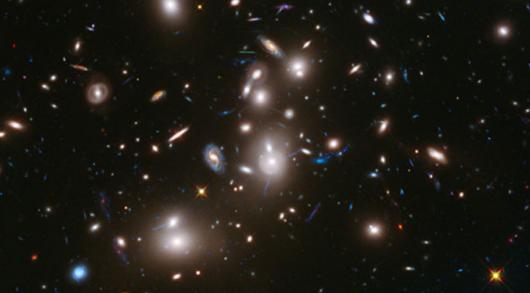Telescope 'travel' back in time 13.2 billion years
The European Space Agency and NASA have introduced the first images of galaxies 13.2 billion years ago, captured by Hubble Space Telescope and Spitzer.
NASA's James Webb Space Telescope Program (JWST) has helped astronomers approach a new step in exploring galaxies at the beginning of the early universe.
Thereby, the Hubble Space Telescope can 'travel' back in time 13.2 billion years - not long after the Big Bang, to capture high-definition images of nearly 3,000 galaxies. in the early stages of the universe.
Thus, scientists discovered three big secrets about galaxies in that period.

The Hubble telescope captured the image of the giant galaxy cluster Abell 2744, showing some of the youngest and faint galaxies ever discovered in space - (Photo: AP)
First , they noticed the brightness of 'ancient' galaxies was 10-20 times lower than today's galaxies.At the same time, scientists can better understand the origin as well as the black holes associated with them.
Second , scientists have observed the four best young galaxies in the galaxy group. In it, the brightest galaxy is made up of stars, at a rate 50 times faster than the Milky Way galaxy today, but its size is only one-twentieth of our galaxy.
And finally , for the first time, scientists can calculate the masses of 'ancient' galaxies using Spitzer telescopes to measure their total brightness.
Thereby, astronomers identify the majority of 'ancient' galaxies are quite small, closer together and emit blue light. They exist everywhere in the universe and are round.
Garth Illingworth, an astronomer at the University of California, USA, said: 'Imagine time travel, back to the 500 million years after the Big Bang - the birth of the universe. You will find it wonderful. '
'Unique' images were announced at the 223 Astronomical Society meeting (AAS) in Washington DC, USA.
- NASA is about to finish the machine looking past 13.5 billion years
- Glass has the ability to look back in time
- Super telescope looks back 13.5 billion years of failed testing
- Can't travel back in time
- Telescope looks back in time 13.5 billion years
- NASA completed the telescope looking back past 13 billion years
- 'The eye' of the gold machine looks back past 13.5 billion years
- Theory to build a traveling machine through time
- The European telescope spotted 72 new galaxies
- 13.3 billion years of cosmic history shrinked in this picture
- Molecular thermometer for distant universe
- Testing a machine looking back past 13.5 billion years
 Van Allen's belt and evidence that the Apollo 11 mission to the Moon was myth
Van Allen's belt and evidence that the Apollo 11 mission to the Moon was myth The levels of civilization in the universe (Kardashev scale)
The levels of civilization in the universe (Kardashev scale) Today Mars, the sun and the Earth are aligned
Today Mars, the sun and the Earth are aligned The Amazon owner announced a secret plan to build a space base for thousands of people
The Amazon owner announced a secret plan to build a space base for thousands of people